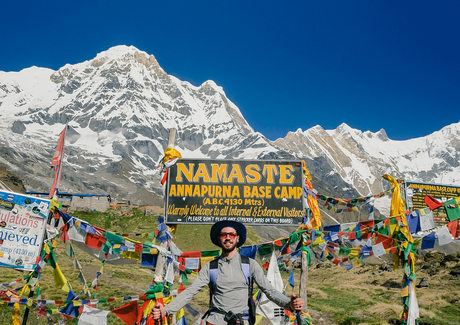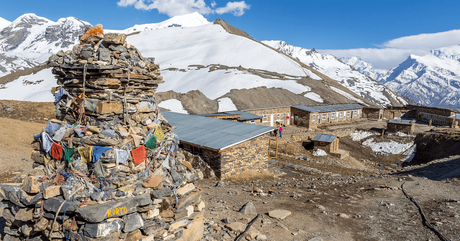
When you are up for trekking, you always think of the fun activities, adventures, and natural beauties to relish. You will be on cloud 9 a night before the trek but do you consider planning and budgeting so that you don’t have to pay a hefty price or be scammed? Especially, when you travel from different countries to the Annapurna base camp, you should be thinking of the proper cost of the Annapurna base camp trek.
Trekking the Annapurna Base Camp is an unforgettable experience, but it’s essential to be aware of the upfront cost. In this guide, we’ll break down the expenses you can incur while on the trek.
From permits and entrance fees to porter costs and food, we’ve got you covered. So whether you’re planning a trekking trip or are just curious about the cost, read on for a detailed breakdown.
Cost Overview and Budgeting

As you decide to do the Annapurna Base Camp trek, you must be sure that you have allocated a sufficient budget.
One of the first things you’re wondering is how much this trek will cost. Well, fear not because we’ve got you covered. In this article, we’ll provide a comprehensive breakdown of all the costs involved in doing the Annapurna Base Camp trek.
We’ll start with an overview of the costs and then go into more detail about each expense.
What Are the Factors That Influence Trek Cost?
Many factors influence the cost of a trek to the Annapurna Base Camp. The highest prices are the airfare to and from Nepal, trekking equipment, and trekking permits. The cost of airfare will vary depending on your location and the time of year you travel.
Trekking equipment can be rented in Nepal or purchased before your trip. The cost of renting equipment is generally lower than buying new gear.
Trekking permits like ACAP and TIMS Card for the Annapurna region are required and can be obtained from the Nepal Tourism Board or your trekking company. The cost of a permit is typically around USD 30. Other costs to consider when budgeting for your trip includes food, lodging, and transportation while in Nepal.
Prices for food and lodging will vary depending on your trekking route and the level of comfort you desire. Transportation costs will also vary depending on your starting point and how much distance you plan to cover.
Accommodation and Facility Costs
When it comes to the cost of the Annapurna Base Camp Trek, there are several things to take into consideration. The first is the accommodation and facility costs, which can range from relatively affordable to downright expensive.
There are many guesthouses and hotels along the trekking route, and the price for a night’s stay will depend on the level of comfort and amenities you desire. Basic guest houses with shared bathrooms can be as cheap as 300 NPR (3 USD), while more luxurious options with en-suite bathrooms and Wi-Fi can cost 2500 NPR (18 USD) to more.
It’s also important to factor in the cost of meals and snacks, which will vary depending on your chosen trekking route. The Annapurna Base Camp Trek’s most popular route features many small villages with local eateries, where you can buy a meal for as little as 100 NPR (0.75 USD). However, if you’re looking for something a little more luxurious, some high-end restaurants in Kathmandu and Pokhara offer Western-style cuisine.
Transportation Charges
Regarding the Annapurna Base Camp trek cost, transportation charges are one of the most significant expenses. It is essential to plan and budget for these costs accordingly.
There are various ways to get to the starting point of the trek. You can fly into Pokhara, the nearest city, or take a bus or taxi from Kathmandu, the capital of Nepal.
No matter how you choose to get to Pokhara, the cost will be approximately USD 100 each way. Once you reach Pokhara, you will need to take a taxi or bus to Nayapul, the starting point of the trek. The cost of this transportation will be around USD 10 per person.
Food and Supplies Expenses
Assuming you’re already in Nepal, the next considerable cost will be food and supplies for your trek. This includes everything from snacks to keep you going during the hike to meals at the tea houses along the way.
Teahouse prices can vary greatly, but a general rule of thumb is to budget around $5-10 per meal. If you’re planning to cook on your own, you’ll also need the cost for gas canisters (around $5 each) and other supplies like spices and instant coffee. All told, you should spend around $20-30 daily on food and supplies.
Equipment Rental, Guide, and Porter Fees
When it comes to trekking in Nepal, you have the option to go it alone or hire a guide. We recommend hiring a guide if you’re planning on trekking to Annapurna Base Camp. Not only will they be able to tell you all about the history and culture of the region, but they’ll also be able to help you navigate the sometimes treacherous terrain.
You can rent a guide for your trekking support, and they charge around $25 to $30 per person. Be assured of being acknowledged by the Annapurna Base Camp and region since your guide will help you communicate with people.
Similarly, you can hire porters who charge anywhere from $17 to $25 per person if you have huge luggage.
As for equipment, you can either bring your own or rent it in Thamel, Kathmandu. Having high-quality gear when trekking is essential, so we recommend renting or buying new if you can. When it comes to renting gear, this is entirely up to you. We recommend renting the equipment if you’re looking for used gear and want to avoid owning it. If you are a passive trekker, renting it is a wise idea. It will be cost-friendly, and you can save money on extra activities.
Miscellaneous Costs and Tips
There are a few miscellaneous costs to consider when budgeting for your Annapurna Base Camp Trek. First, you’ll need to factor in the cost of your visa. A single-entry visa for Nepal costs $25 USD, while a multiple-entry visa costs $40. You’ll also need to pay the Nepalese government a trekking permit fee of USD 20.
You should also have some extra money set aside for tips. It’s customary to tip your guide and porters at the end of the trek, and 10-15% of the total cost of the hike is a good rule of thumb.
Finally, remember to budget for souvenirs! There are plenty of great souvenirs in Nepal, so you’ll want to ensure you have some spending money set aside. A good rule is to budget $10-20 USD daily for souvenirs.
How To Minimize Your Cost?
Assuming you are looking to do the Annapurna Base Camp Trek on a budget, there are a few ways you can minimize the cost. First, you could choose to trek during the offseason. The offseason for Nepal is typically October through December and March through May. During these times, accommodation and guide prices are significantly lower than during peak season.
Additionally, there are likely to be fewer people on the trail, so you may have a more intimate experience with the mountains. Second, consider homestay instead of staying in a lodge or hotel. Homestays are becoming increasingly popular in Nepal and offer travelers a chance to immerse themselves in Nepali culture. Not only will you save money by staying in a home, but you will also get to know your hosts and learn about their way of life.
Finally, you could carry your gear instead of hiring a porter. This option is only for some, as carrying your equipment can be challenging. But if you are ready for the challenge, it will save you some money. You can minimize the cost of your Annapurna Base Camp Trek and have a fantastic experience on a budget with this plan.
So there you have it: an Annapurna Base Camp Trek cost. We hope this has been helpful and that you better understand what to expect financially when planning your trip.
